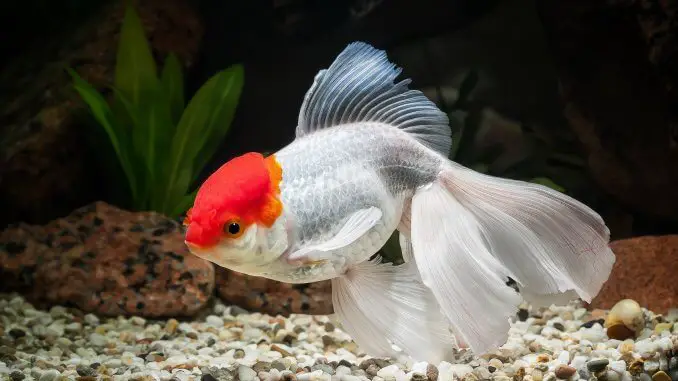
The oranda goldfish is a freshwater fish of the Cyprinidae family. These fish are a product of selective breeding and are closely related to the common goldfish.
This goldfish species has a fleshy cap on its head and comes in a variety of colors that make the fish popular among aquarists. Orandas are peaceful fish and can coexist with other temperate species of similar size.
TABLE OF CONTENTS
Oranda Goldfish Facts & Overview
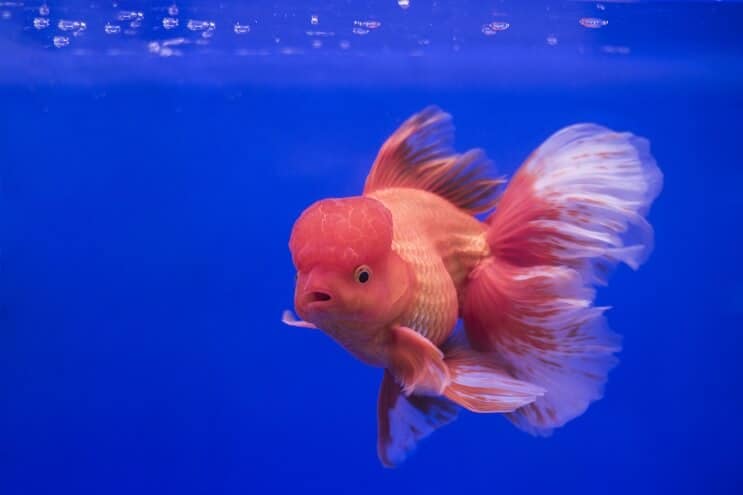
| Scientific name: | Carassius auratus auratus |
| Common names | Red cap goldfish, bullhead oranda goldfish |
| Distribution: | Worldwide |
| Size: | 8–9 inches |
| Life expectancy: | 15 years |
| Color: | Orange, red, red-and-white, red-and-black, black, blue, chocolate, bronze, white or silver, black-and-white, red-black-and-white, and calico |
| Diet: | Omnivore |
| Temperament: | Peaceful |
| Minimum tank size: | 20 gallons |
| Temperature: | 65–72°F (17–22°C) |
| pH: | 5.0–8.0 |
| Hardness: | 5–19 dGH |
| Care level: | Moderate |
| Breeding: | Egg-layer |
Origin
The oranda goldfish (Carassius auratus auratus) is a result of selective breeding. The exact origin of this goldfish species is unknown, but these fish are one of the older varieties of fancy goldfish developed by Asian breeders. Like all other goldfish, orandas are descendants of wild carp — known as Prussian carp.
Oranda goldfish are distributed worldwide and kept in aquariums and ponds. The International Union for Conservation of Nature and Natural Resources (IUCN) doesn’t list the oranda because there are no wild populations of this captive-bred fish species.
Adult Size & Lifespan
The oranda goldfish is around 8 to 9 inches long, but some goldfish grow much larger depending on the individual genetic makeup and tank conditions. The largest oranda goldfish was bred in Hong Kong and reportedly measured 14 inches in length.
Male and female oranda goldfish look the same, except during the breeding season. During the spawning season, females swell with eggs. The distended belly makes the female larger than the male and reveals her gender.
The average lifespan of oranda goldfish is 15 years. When raised in a large and well-maintained tank, these fish are known to live up to 20 years.
Availability
The oranda goldfish is one of the most popular types of goldfish and is easy to find in pet stores.
These online stores regularly have oranda goldfish available:
A single oranda goldfish costs $12 to $320, depending on the color.
Appearance & Behavior

The oranda goldfish’s most distinctive feature is the fleshy overgrowth on the upper part of the head. Similar to other types of goldfish, orandas are peaceful fish that get along with other placid fish in the tank.
Colors, Patterns, Fins, and Sex Differences
Oranda goldfish are unlike typical goldfish and are easily recognizable by the prominent raspberry-shaped cap on the head. Known as the wen or crown, the oranda’s cap may be located on the top of the head or may cover the entire face, except the mouth.
The cap doesn’t appear until the oranda is three to four months old, and forms fully in the next one or two years. The cap continues to grow until an oranda goldfish is around two to three years old.
This species is an egg-shaped type of goldfish with a large belly that’s almost as wide as the oranda is long. The body is covered in shimmering metallic or matte scales that come in various colors. Orandas come in red, black, calico, chocolate, red-and-white, blue, and red-black-and-white combinations.
Most oranda goldfish are orange or yellow in color, but there are several popular color varieties. Black oranda goldfish have the same physical traits but have a completely black body. Blue oranda goldfish are very colorful fish and range in color from light bluish-gray to deep blue.
The red cap oranda is the most popular color morph of the oranda goldfish. Red cap orandas have almost white bodies and bright-red head caps. The red cap oranda’s wen rarely covers the fish’s face and is smaller than the cap of other oranda goldfish.
Except for the dorsal fin, all of the oranda’s fins are paired, giving the fish a symmetrical appearance. The long and flowing caudal fin fans out whenever the fish isn’t swimming.
As spawning season begins, males develop bumps on their heads and pectoral fins, known as tubercles. During this time, the bellies of females swell with eggs.
Typical Behavior
Oranda goldfish are peaceful community fish that do well with other temperate fish of similar size. These goldfish aren’t fast swimmers but are full of energy and are enjoyable to look at. The oranda spends most of its time swimming and uprooting plants.
This species swims all over the tank and can be found at the bottom and the top. Unlike other fish, orandas don’t hide and spend most of their time in the open.
Oranda Goldfish Care & Tank Requirements
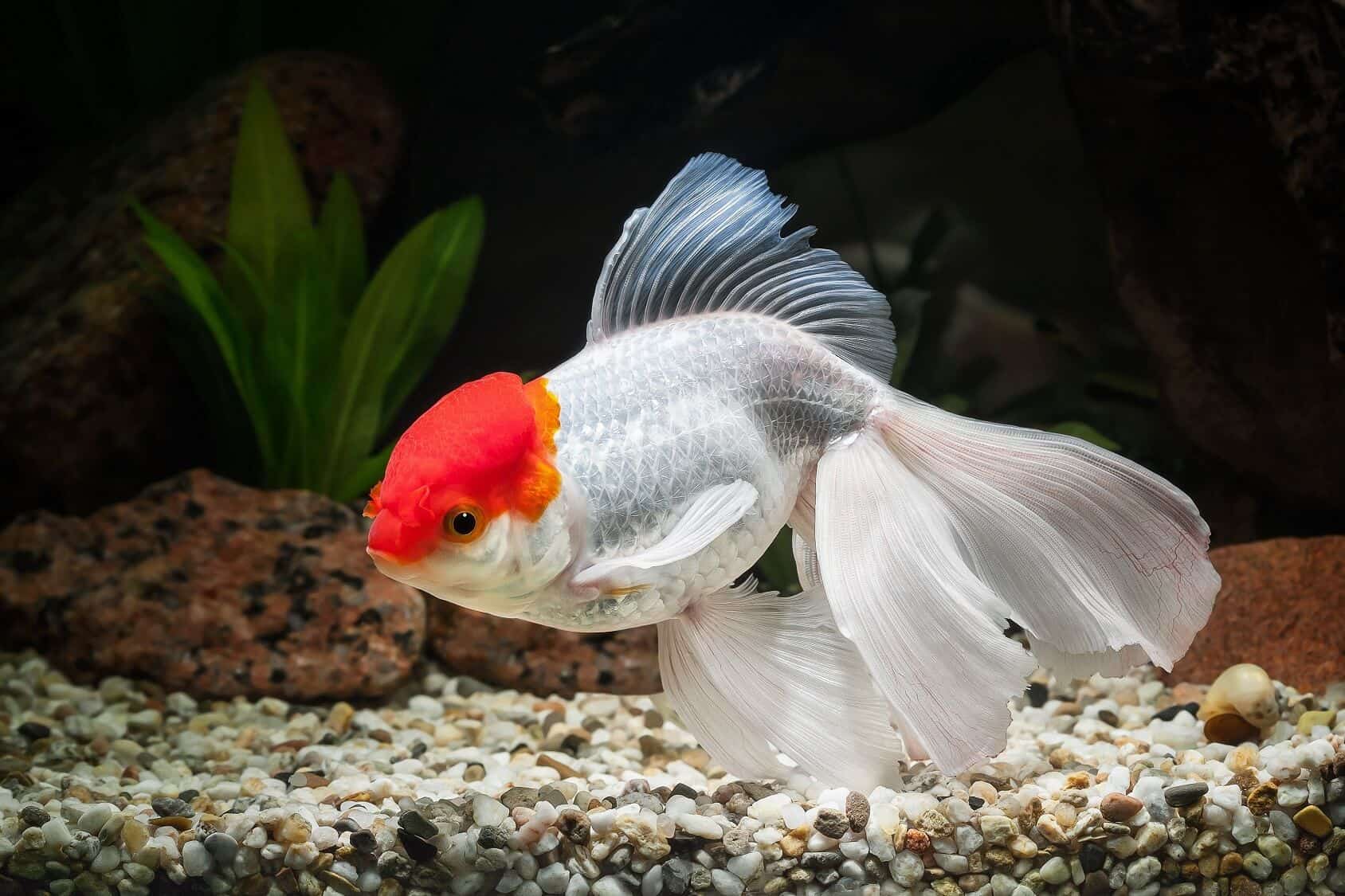
The oranda goldfish is one of the more delicate species of goldfish and is recommended for intermediate fish enthusiasts. These fish aren’t suitable for outdoor ponds or beginner aquarists.
Orandas are a product of selective breeding and don’t have a natural habitat. Unlike flat-bodied types of goldfish, this species doesn’t tolerate poor water quality and low temperatures. A large tank with clean, oxygen-rich water and a sandy bottom will make an oranda goldfish feel at home.
These goldfish are omnivores and eat flakes, and frozen or fresh foods including brine shrimp, blood worms, and tubifex worms.
Habitat and Tank Requirements
Orandas are more sensitive than other types of goldfish and need a well-maintained tank to stay healthy and happy.
The aquarium’s size and shape are important for the oranda’s health and happiness. To reduce the risk of oxygen shortage and stunted growth, provide the maximum surface area by choosing an elongated tank.
Orandas are the result of selective breeding, so there’s no natural habitat to compare to when setting up a tank. However, most baseline parameters are similar to those of the oranda’s wild carp ancestors.
Clean water is essential, and weekly water changes of 25–35% are recommended. Orandas produce more waste than most freshwater fish and benefit greatly from a good filtration system and regular water changes.
Orandas are diggers, and sharp gravel or rough substrates could injure the fish. Use rounded gravel or fine sand to cover the bottom of the tank. Decorate the oranda’s tank with smooth rocks or ornaments without sharp edges or protruding points.
Plants are the best aquarium décor for this species. These fish need lots of space to swim freely, so choose small and sturdy plant varieties that won’t restrict the fish’s movements.
Orandas like to nibble on plant leaves and dig in the substrate, uprooting plants in the process. Artificial silk plants are a great alternative to live plants and plastic plants.
Tank Conditions
A minimum tank size for a single oranda goldfish is 20 gallons, though a 30-gallon tank is preferred. Increase the size of the tank by 10 gallons for each additional oranda goldfish.
Adult orandas are around 9 inches long and need a spacious tank to grow. Keeping an oranda goldfish in a small tank leads to stunted growth. When these fish can’t swim freely, they become stressed and ill.
Orandas are sensitive to low water temperatures and can’t tolerate temperatures below 60°F. Invest in a good water thermometer and monitor the water’s temperature regularly. The best temperature for oranda goldfish is between 65–72°F.
Besides a good filtration system, invest in a strong aeration system to maintain high oxygen levels in the water. Despite their impressive size and flowing fins, oranda goldfish aren’t good swimmers and don’t deal well with strong water movements. Reduce the water flow of the aquarium filter with rocks, caves, and plants, or restrict the flow at the filter’s intake.
| Water type: | Normal freshwater |
| Tank size: | 20-gallons minimum, 30-gallons preferred |
| Water temperature: | 65–72°F (17–22°C) |
| Substrate: | Sand, rounded, medium-sized gravel |
| Tank setup: | Plants, smooth rocks, decorations without sharp points or edges |
| Acidity: | 5.0–8.0 pH |
| Water hardness: | 5–19 dGH |
| Filter: | Yes, oranda goldfish create a lot of waste and need a powerful filtration system |
| Pump: | Yes, these fish prefer living in highly-oxygenated waters |
Oranda goldfish need a well-maintained tank to stay happy and thrive. Provide a sizable aquarium, a powerful filtration system, and an air pump to maintain water quality and high oxygen levels to support the health of this fish species.
Disease
Like any other freshwater fish, oranda goldfish are susceptible to common fish diseases. But, these fish are hardy, and if treated promptly, most oranda’s recover fully.
Oranda goldfish may suffer from the following diseases:
- Ich is a common protozoan disease that affects many species of freshwater fish. This condition is characterized by white spots across the fish’s body, gills, and fins. Ich is a highly-contagious disease, so quarantine the affected fish to stop the spread of the disease. Treat the affected fish with non-iodized sea salt or antiparasitic medication
- External parasites, like flatworms or argulus (fish lice), are often introduced into a tank on food and live plants. Flatworms attach to the fish’s body and gills using the hooks around their mouths. Fish lice are flattened, mite-like parasites that attach themselves to the oranda’s body. Non-iodized sea salt is the best natural treatment for fish lice, but chemicals like diflubenzuron are effective as well
- Swim bladder disease often affects round-bodied fancy goldfish, including orandas. Fish with this illness can’t maintain their position in the water. This condition has several causes, but constipation is the most common. Treatment involves feeding the fish frozen or defrosted peas or withholding food for 24 hours
- Overgrown head cap is a condition that affects oranda goldfish. In some cases, the cap grows so much that it obstructs the fish’s vision and ability to eat. The overgrown portion of the cap can be removed surgically
Tank Mates
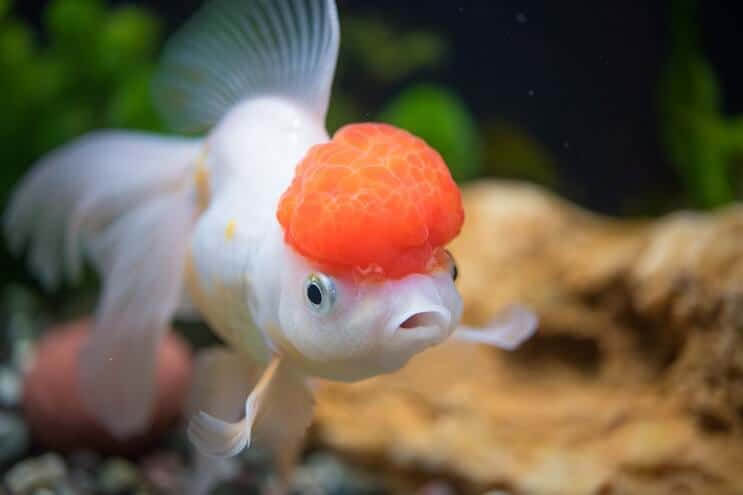
The social and peaceful oranda goldfish thrives in a community. These fish aren’t fast swimmers and can’t compete for food with fast-swimming types of goldfish. Avoid keeping orandas with faster goldfish species like shubunkins, common goldfish, and comet goldfish.
Orandas do best when housed in a community of their own kind or with other fancy goldfish.
Great tank mates for oranda goldfish include:
- Peppered cory catfish
- Sailfin pleco
- Pearlscale goldfish
- Black moors
- Ryukin goldfish
Non-fish aquarium species, like snails, aren’t good tank mates because they might get eaten by the oranda.
Diet and Feeding
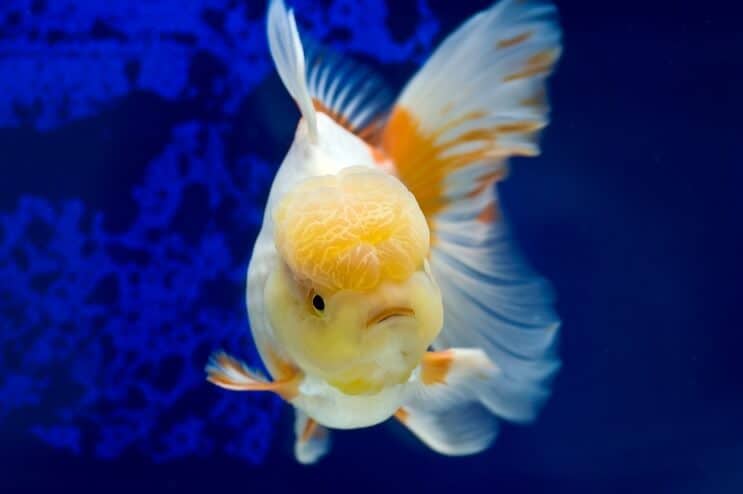
The omnivorous oranda goldfish eats all kinds of fresh, frozen, and flake foods. These fish are greedy eaters and will eat any meal.
To keep oranda goldfish healthy, feed them high-quality flake food every day. Offer frozen or live brine shrimp, tubifex worms, blood worms, or Daphnia every other day as a treat. Freeze-dried foods are better because live foods may be contaminated with parasites and bacteria.
These fish are prone to overeating so look for signs, including swimming upside down and constipation. If your oranda goldfish is flipped over and swimming on its side, withhold food for 24 hours and then resume feeding smaller portions.
Adult orandas should eat once a day, while young fish require two meals a day. Orandas with overgrown caps need extra time to feed because the wen affects their ability to see and eat food.
Breeding
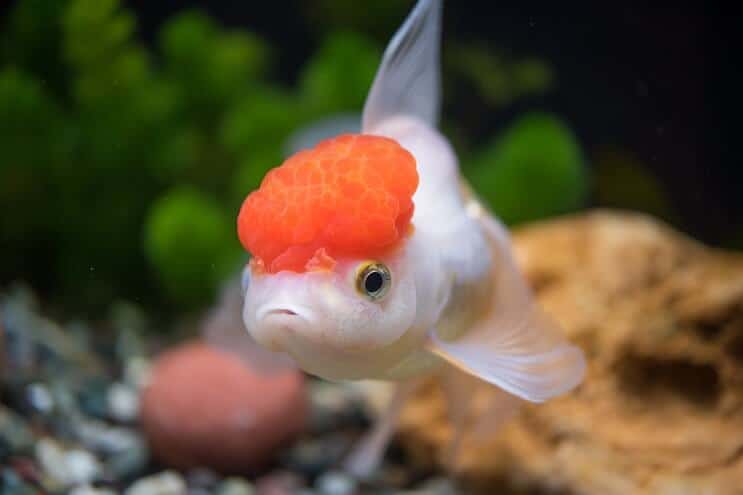
Oranda goldfish are easy to breed in the right conditions. These fish can be bred in small groups of up to five individuals but are likely to breed in large groups as well. Goldfish usually spawn in late spring or early summer, so breeders need to mimic the conditions found in nature.
Keep the male and female orandas separated for a few weeks before introducing them into the breeding tank simultaneously. Set up the breeding tank with solid surfaces, bushy plants, or fibrous spawning mops for the eggs to adhere to.
Slowly decrease the temperature in the breeding tank to 60°F and then gradually increase the temperature at a rate of 3°F per day until the spawn. Oranda goldfish begin spawning when temperatures are between 68 and 74°F. To induce spawning, feed small amounts of high-protein food like live brine shrimp or worms three times a day.
Before spawning occurs, the male oranda goldfish will chase the female in a non-aggressive way. During the spawn, the fish gyrate from side to side. The male pushes, then, the female into plants, where she drops the eggs for the male to fertilize. Female orandas can lay upwards of 10,000 eggs in two to three hours.
Remove both parents as soon as the spawning is complete to prevent them from eating the eggs. It takes four to seven days for fertilized eggs to hatch, depending on the water’s temperature.
Feed the newly hatched fry, infusoria, or specialty fry foods until the fish become big enough to eat brine shrimp or flakes.
Should You Get an Oranda Goldfish for Your Aquarium?
The oranda goldfish is a social and peaceful community fish that gets along with other peaceful species of similar size. Orandas are more sensitive than other types of fancy goldfish and are best suited for intermediate aquarists.
The oranda goldfish is an interesting type of freshwater fish that will add a touch of color and an unmatched level of beauty to any aquarium.

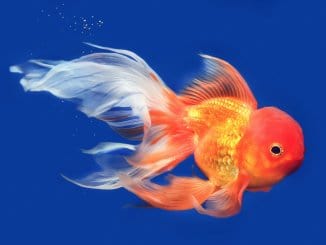
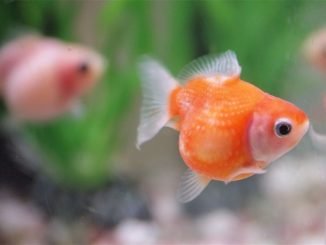
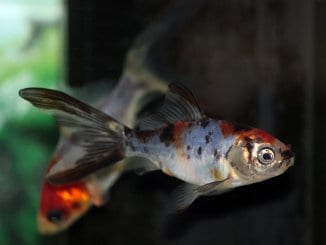
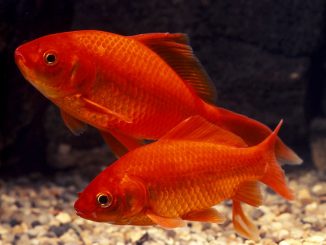
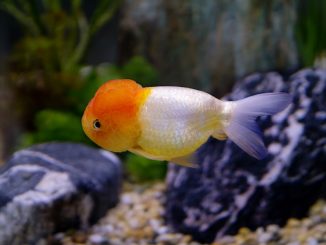
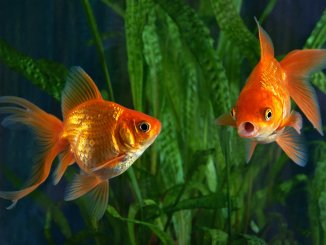
I love my Orandas. I have two that I believe to be female. They are between 1-2yrs old and about 6-7 inches long. They have such a personality and can differentiate me from other people. They will actually shy away from strangers but come to me readily to be fed from my hand.
I have a black orange. He has a swim blade issue. I’ve been feeding him peas for two days now and he’s still the same head downward. Any ideas? Thank you. Have a blessed day.
I’m new to Fishkeeping … have 6 goldfish and 2 plecos
… My tank is still under a year old .. unfortunately have lost a few fish but the ones I now have seem to be doing just fine .. it’s a big tank .. 350 litres and am considering adding a couple more fish .. I came upon your site by accident but am so glad I did so .. have been reading up on all the info .. love this site and looking forward to reading many more articles ..
Hi , My oranda is facing a constipation problem will you please advise me what would I do to treat this disease.
Thanks.
Hi Abdul, constipation is usually caused by too much fibre. Do you feed your Oranda a varied diet rather than just flake foods? Thanks, Robert
Feed it green peas. You must squeeze the meat out of the shell. Don’t feed them the shell. Can peas.
Hello I fall in love with Oranda the first time I saw one but at that time I was just starting a new tank and didn’t know much about Oranda at the time but now I learn more about them and I felt in live with them more and more they will greet me or say hi everytime I go into my kitchen and when my two kids come home for visit I live in GA and it can get very hot I want to know if you can tell me what plants are good to keep in the tank with Orandas
Hi Christine, Oranda’s certainly are beautiful little fish. Anubias, Java Fern and Crypt Wendtii are all great plants to keep with Goldfish. Thanks Robert
Hi just started to keep orandas. I just st love them. I put in the tank some Danio fish but it looks like they are not compatible as the Oranda seemed stressed. Now I removed the Danio and everything seems fine.
I would like to ask how do you recognise which one is female and which one is male?
Thank you
Hi Roxana, good choice in removing them if they looked stressed. Males are usually smaller than females, the vent (opening under the anal fin) is usually rounder and more pronounced in females, the pectoral fins are usually thicker in males, during the breeding season the female is wider than the male and the male will develop small white bumps (tubercles) on the head and gills. Hope that helps! Robert
My guy actually begs for food bl making a clicking noise by spitting out the water, is it normal for them to beg?
Hi Greg, I have seen this behavior before. They have quite the personality! Robert
I just started my aquarium a couple days ago and yesterday I got two orandas and I’m having a big problem. First the filter stopped working and then they were in the tank without a filter. It think for a solid 8 hours. I couldn’t do anything better because I was at school at that time.Then when I got a new filter I saw one of my goldfish’s tail had a black dot and there a scale that came off too. I’m so scared they will die can someone help me out?
Hi Kayan, would it be possible to return the fish to the store until your tank is properly ready? You need to leave your tank for a minimum of 4 weeks to ensure that the nitrogen cycle starts to establish and that the ammonia and nitrite contents aren’t too high for your fish. The mark could be a burn mark from the high ammonia levels in the water. Thanks, Robert
Can I feed my orandas with tetra bits , optimum 3 in and optimum complete mixture ??
Hi,My Oranda has laid eggs for at least 3 times but nothing hatched. Last time I even tried handspawning. How does it look like when it is fertilised? It is having white dot at centre and rest all transparent.Male is common goldfish and female is oranda. Is that the problem?
Can you help with it for both natural and hand spawning?
Hope you reply quickly.
Thank you.
Hii, one of my black oranda gold fish is not moving, just staying still in the bottom of the tank, while rest oranda gold fish are moving freely. So what should o do so thaty fish remain active like others.
Thanks, Amol
Please PLEASE HELP!i have a red cap oranda named Bob I love so much. Temp good and so is water in tank but I believe he is constipated and a day ago started swimming on side but now lays at bottom of tank with breathing seeming very less and less . He started to pass a little bit still hasn’t gotten it out. I don’t want hi
To die but fear it’s moments from happening and I’ll do whatever I can to save him please help
It seems these replies are taking three days to get and I’m afraid my fish has three hours or so , if anyone could help me I’d appreciate it. My fish Bob is fighting hard to stay alive and I want him to have the very best fighting chance possible
Im keeping my oranda with my angel fishes…and angelfish are from the cichlids family-idek if its okay to put them in one tank…:/
I’m very new to the fishy caretaker world and I have had a beautiful golden Oranda for a little over a year (he was a rescue that was dropped on my doorstep and I had a rough overnight crash course of basic fish care) and he doesnt like to even nibble at anything else other than flakes and is constantly having swim bladder issues. We’ve monitored the water levels and temperature and even given it some baths in aquarium salted water. We’ve had trouble getting the levels to be right, every time we get it about right, it seems to go wonky over night. We have no substrate and a few marimo moss balls in for now to try to help with the nitrates and ammonia because at one point we were almost doing daily water changes from the filth, and no substrate helped keep it cleaner. Now recently he developed a more severe swim bladder issue where he’s sleeping upside down then will swim off normally. I tried giving him the recommended pieces of pea but the little dummy doesn’t see it as food at all. He just lets it rot. I dont want to force feed him it for fear of choking him. What do we do? We just did a fresh full tank change. He has clean water, clean tank, correct temperatures, but the swim bladder problem isn’t going away. What can I do to save him so he doesn’t die on me at just under two years old? And to add to my frustration, theres no vet near me that treats fish. Just Cats and dogs, sometimes lizards but not fish.
Hi, I was looking to get an Oranda as a gift but was not looking for a large scale tank (20 gallons) would something smaller work too (maybe ten gallon tank)? If you have any suggestions let me know, thanks!
20 gallon minimum unfortunately
i have 2 orandas in a 4 liter tank. is that enough space for both of them?
20 gallons for first fish and 10 gallons for each additional fish is recommended.
I have 4-5”Orandas, Black Moor and Ryukin. 125 gallon aquarium. What is the best size and type filtration for them?